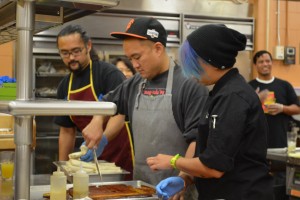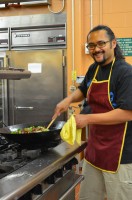A Filipino Feast (+ recipe!)
by J. Besl |

In a city with the most diverse high schools in the entire country, Anchorage residents have a literal world of culinary options ahead of them, from German sauerkraut to Vietnamese Pho to Somali food trucks and Samoan pancake houses.
So in a state with almost 20,000 Filipinos-the largest Asian group in the state-where are all the Filipino restaurants?
That was one question Jessica Petalio and Dennis Perez wanted to discuss at a recent meeting of UAA's Filipino American (Fil Am) club, a campus group for Filipino American students. The new group meets in a fun social environment built around a weekly theme, like immigration history or folklore. Recently, as part of Filipino American History Month, the group discussed everyone's favorite topic-food.
Food is a pillar of nearly every cultural community, but especially in the Philippines. Filipinos often greet guests with the Tagalog question "Kain ka na?," or "have you eaten yet?"
"Even before we say, 'How are you?' It's 'Have you eaten yet? Let's go eat!" Jessica laughed.

But food is always about more than just nutrients. There are subtle messages in everything food-related: who sits first, who cooks what, when are you comfortable enough to eat leftovers off someone's plate. Food can also be a history lesson, too. Filipino cuisine, for example, evidences the diverse influences on the culture both at home (through centuries of Spanish and American imperialism) and abroad (10 million Filipinos live outside the island nation). That complex history of colonialism and migration has left a history visible in the cuisine.

"We're such an adaptive culture," Dennis said, citing the international origins of common Filipino dishes. To make their point, Jessica even presented an animated PowerPoint on the worldwide saturation of Spam (the canned military meat is a familiar fixture in Filipino dishes).
The Philippine's diverse culinary heritage was on full display last Saturday, as the new student club joined with the existing Alaskero Partnership Organizers-a Filipino faculty and community workgroup at UAA-to host the university's annual celebration of Filipino American History Month. Traveling chef Yana Gilbuena returned to Anchorage last weekend to prepare a meal for 100 guests in the first large event co-hosted by the fast-growing Fil Am Students club.
Golden idea from the Golden State
The club is still finding its feet, but it has quickly filled a void on campus.
Both Jessica and Dennis attended universities in California where Filipino American clubs were a major fixture of campus life. At San Francisco State University, where Jessica earned her undergraduate degree, there wasn't just one club, but five (including a Filipino fraternity and two Filipina sororities). "I was surrounded by it," she said. When she arrived at UAA to start her Ph.D. in clinical-community psychology, she was surprised UAA didn't even have one student club.

"We had the best times of our lives at our organizations," said Dennis, a senior airman at JBER who attended the University of California, Davis and California State University, Sacramento. The two decided to create that same experience for students at UAA.
Initially, Jessica and Dennis just wanted to gauge interest and ideas from other students. Should this be more educational or social? Will we focus on academic mentoring or cultural events? Do we sign an official charter or keep it loose and low-key? Those questions are still in the air. The club has only been meeting for the past few weeks.
Attendance, though, has exploded. In just under a month, meetings jumped from three students to nearly 30, indicating a definite interest in a Filipino student group on campus.

"We're seeing new faces every single week," Jessica said. "We're really excited."
"It's an awesome turnout, and that's really gratifying for us," Dennis agreed.
The club has a multitude of benefits for students. Primarily, it creates a fun environment for students who share a common thread. That connection, though, can hold mighty benefits.
"There's a large dropout rate for Filipino Americans in high school and college," Jessica said. In her experience in California, Fil Am clubs positively affect students and provide both the motivation and support to make the most of college. That need is magnified in Alaska, where many Filipino-American students are moving to UAA from small fishing towns like Unalaska and Kodiak. She hopes to establish more direct mentoring in the future, where seniors can connect with incoming students in every department. That mentorship, she says, "hopefully creates more of a success rate for Filipinos to attend and graduate from UAA."
Weekly club meetings are open to the entire campus community. Find out what they're up to next on Facebook.

Kain ka na?
October is Filipino American History Month, and for the past several years the professor-led Alaskero Partnership Organizers have put together a cultural event on campus. This year, they had a swell of student involvement thanks to the new club.
And it came with a special guest in traveling chef Yana Gilbuena, who spent last year on a quest to cook Filipino food for Filipino communities in all 50 states (Alaska, which she visited last August, was state #25). Since wrapping her American journey-which she dubbed the SALO Project-she has done the same for Canada's territories and provinces, and has her eyes set on South and Central America next. But last week, she was back here in Anchorage.

She cooked for roughly 20 people when she was in town last August. This year the guest list expanded to 100, making it the largest crowd she's cooked for on her tour. "I'm very happy to be back here again," Yana said as she prepared to take over the kitchens in Cuddy Hall Friday and Saturday.
Food was plated on the center of each table, though without any plates, as food is eaten with your hands in traditional Filipino culture. Surfaces were covered in banana leaves as students dished out Yana's culinary creations. The menu included Bringhe, a type of paella cooked with turmeric and coconut milk, as well as sisig, a meaty dish of pig head and chicken liver marinated in Thai chilies, soy and lime. Yana also prepared pancit, a salty noodle dish with smoked fish, chicken and coconut, and capped the meal with halo-halo, a popular dessert that literally means 'mix-mix' and can include anything from jello to ice cream to tropical fruits to deep-fried egg rolls.

Though Filipino American History Month is ending, the Fil Am Students club is just getting started. If you missed the meal this time around, stay tuned to the group's Facebook page to see what else they have in store for the campus community. Though Jessica and Dennis launched the club, the leadership is shifting to UAA juniors Rachell Gulanes and Claudine Tungul. You can reach them directly at rtgulanes@alaska.edu and ctungul@alaska.edu.

Sisig recipe
Feeling inspired? Have access to pig ears? Check out Yana Gilbuena's sisig recipe-and accompanying prep video from Citizen Brooklyn-below.
Ingredients:
- 2 lbs. pigs ears
- 2 lbs. pork belly (sliced)
- 1 lb of chicken liver (pureed)
- 1 cup of red Thai chilies (chopped)
- 2 medium red onions (diced)
- 1/2 cup of garlic (diced)
- 1/2 cup of soy sauce
- 1/4 lemon/lime juice
- 4 eggs
- Mayo (Kenko or Kewpie mayo)
Procedure:
- In a large pot, boil pigs ears and pork belly together for 30 minutes.
- Pre-heat oven to broil or convection bake at 425.
- After the meat boils, place in sheet pan and put in oven.
- Broil/convection bake for 30-45 minutes, until crispy *Save the pork fat oil
- After meat crisps, dice into small cubes.
- Saute garlic in pork fat (from broiling) until golden, then add onions, chilies and chicken liver.
- Add diced meat, soy sauce and lime juice.
- Mix and saute until liver is cooked.
- Crack eggs on top, then continue sauteing.
- Stop when eggs are done.
- Add a dollop of mayonnaise on top and serve.
 "A Filipino Feast (+ recipe!)" is licensed under a Creative Commons Attribution-NonCommercial 4.0 International License.
"A Filipino Feast (+ recipe!)" is licensed under a Creative Commons Attribution-NonCommercial 4.0 International License.









